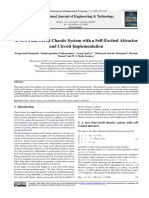Circom 30
Uploaded by
Mada Sanjaya WsCircom 30
Uploaded by
Mada Sanjaya WsRecent Advances in Telecommunications and Circuit Design
Numerical Simulations in Jerk Circuit and Its Application in a Secure Communication System
A. SAMBAS1, M. SANJAYA WS1, M. MAMAT2, N. V. KARADIMAS3, O. TACHA4
1 3
Bolabot Techno Robotic School, Sanjaya Star Group Jl. A.H. Nasution No. 105, Bandung West Java INDONESIA
2
Informatics LAB Faculty of Mathematics & Engineering Sciences Department of Military Science Hellenic Army Academy Athens, GR-16673 GREECE
4
Department of Mathematics Universiti Malaysia Terengganu 21030 Kuala Terengganu MALAYSIA
Department of Mechanical Engineering Aristotle University of Thessaloniki Thessaloniki, GR-54124 GREECE
acenx.bts@gmail.com, nkaradimas@ilabsse.gr, rtacha@auth.gr
Abstract: - In this work, the case of synchronization between two mutually coupled identical chaotic circuits, for use in a secure communication scheme, is studied. The chosen circuit is the well-known Jerk circuit with a simple nonlinear function. By using various tools of nonlinear theory, such as phase portraits, Poincar maps, bifurcation diagrams and Lyapunov exponents, the chaotic behavior of this system is confirmed. The comparison of the results between the numerical simulation using the MATLAB and circuits simulation with the MultiSIM verifies that the Jerk circuit presents the expected behavior. Finally, the effectiveness of the mutually coupling scheme between two identical Jerk circuits in a secure communication system is presented in details. Key-Words: - Jerk circuit, chaotic synchronization, bidirectional coupling, Poincar map, bifurcation analysis, Lyapunov exponents, secure communication system.
1 Introduction
Chaos is generally defined as a state that exists between definite and random state. It is a very interesting phenomenon and has been intensively studied during the last four decades. The characteristics of chaotic systems can be used in many practical applications, such as secure communications [1-2], chemistry [3], biology [4,5], robotic [6], bits generators [7], psychology [8], ecology [9-10], economy [11,12], and cryptography [13]. Pecora and Carroll first demonstrated how chaotic systems could be synchronized, using an electronic circuit coupled unidirectionally to a subsystem made up of components of the parent
systems [14]. This innovation provided a new perspective on chaotic dynamics and inspired many studies on synchronizing chaotic systems. Cuomo and Oppenheim further expanded the area by demonstrating how synchronized chaotic systems could be used in a scheme for secure communication [15]. The plan of the paper is as follows. In section 2, the details of the proposed autonomous Jerk circuits simulation using MATLAB 2010 and MultiSIM 10.0, are presented. In Section 3, the bidirectional coupling method is applied in order to synchronize two autonomous Jerk circuits. The chaotic masking communication scheme by using the above mentioned synchronization technique are
ISBN: 978-960-474-310-0
190
Recent Advances in Telecommunications and Circuit Design
presented in Section 4. Finally, in Section 5, the concluding remarks are given.
So, from the diagram of Lyapunov exponents of Jerks system of Fig.2, the expected chaotic behavior, from the same set of parameters and initial
Phase Space Jerk Circuit 2 1.5
2 Jerk Circuit
Sprott found the functional form of threedimensional dynamical systems which exhibit chaos. Jerk equation has a simple nonlinear function, which can be implemented with an autonomous electronic circuit. In this work, the Jerk circuit, which was firstly presented by Sprott in 2000 [16], is used. This is a three-dimensional autonomous nonlinear system that is described by the following system of ordinary differential equations: =y x =z (1) y = az by + x 1 z This equation has only one nonlinear term in the form of absolute value of the variable x. The parameters and initial conditions of the Jerk system (1) are chosen as: (a, b) = (0.6, 1) and (x0, y0, z0) = (0, 0, 0), so that the system shows the expected chaotic behavior.
signal y
0.5
-0.5
-1
-1.5 -2.5
-2
-1.5
-1
-0.5 signal x
0.5
1.5
(a)
Phase Space Jerk Circuit 2 1.5 1 0.5
signal z
0 -0.5 -1 -1.5 -2 -1.5
2.1 Numerical Simulations Using MATLAB
In this Section the numerical simulations are carried out using MATLAB 2010. The four-order RungeKutta method is used to solve the differential equations of system (1). Figs.1(a)-(c) show the projections of the phase space orbit on to the xy plane, the yz plane, the xz plane, respectively. As it is shown, for the chosen set of parameters and initial conditions, the Jerk system presents chaotic attractors of Rossler type. Also, it is known from the nonlinear theory, that the spectrum of Lyapunov exponents provides additional useful information about systems behavior. In a three dimensional system, like this, there has been three Lyapunov exponents (1, 2, 3). In more details, for a 3D continuous dissipative system the values of the Lyapunov exponents are useful for distinguishing among the various types of orbits. So, the possible spectra of attractors, of this class of dynamical systems, can be classified in four groups, based on Lyapunov exponents [17]. (1, 2, 3) (, , ): a fixed point (1, 2, 3) (0, , ): a limit point (1, 2, 3) (0, 0, ): a two-torus (1, 2, 3) (+, 0, ): a strange attractor (Fig.1).
-1
-0.5
0 signal y
0.5
1.5
(b)
Phase Space Jerk Circuit 2 1.5 1 0.5
signal z
0 -0.5 -1 -1.5 -2 -2.5
-2
-1.5
-1
-0.5 signal x
0.5
1.5
(c) Fig.1. Numerical simulation results using MATLAB 2010, for a = 0.6, b = 1: (a) x-y plane, (b) y-z plane, (c) x-z plane.
conditions, is confirmed.
Bifurcation theory was originally developed by Poincar. It is used to indicate the qualitative change in a systems behavior, in terms of the number and the type of solutions, under the variation of one or more parameters on which the system depends [18].
ISBN: 978-960-474-310-0
191
Recent Advances in Telecommunications and Circuit Design
To observe the system dynamics under all the above possible bifurcations, a bifurcation diagram may be
Dynamics Lyapunov exponent 0.6 x y z
map. In the chaotic state the phase portrait is very dense with the traces of the motion. It can be only
Poincare Map Analysis Jerk Circuit 2 1.8
0.4
1.6
Lyapunov exponents
x(n+1)
0.2
1.4
1.2
0
1
-0.2
0.8
-0.4
0.8
1.2 x(n)
1.4
1.6
1.8
(a)
-0.6
Poincare Map Analysis Jerk Circuit 0.06
-0.8
20
40
60
80
100
120
140
160
180
200
0.04
Time (s)
0.02
Fig.2. Diagram of Lyapunov exponents of the Jerk system, for (a, b) = (0.6, 1).
y(n+1)
-0.02
-0.04
-0.06
-0.08 -0.08
-0.06
-0.04
-0.02 y(n)
0.02
0.04
0.0
(b)
Poincare Map Analysis Jerk Circuit 2
1.5
z(n+1)
0.5 0 -0.5 -0.5
0.5 z(n)
1.5
Fig.3. Bifurcation diagram of x vs. the control parameter a, for b = 1, with MATLAB 2010. constructed, which shows the variation of one of the state variables with one of the control parameters. A MATLAB program was written to obtain the bifurcation diagram for the Jerk circuit of Fig.3. So, in this diagram a possible bifurcation diagram for system (1), in the range of 0.55 a 1, is shown. For the chosen value of a = 0.6 the system displays the expected chaotic behavior. For 0.6 < a 0.76, a period-2 behavior system and finally for a > 0.76 a period-1 behavior system is shown. Another useful tool for analyzing the dynamical characteristics of a nonlinear system is the Poincar
(c) Fig.4. A gallery of Poincare maps for system (1) for a = 0.6, b = 1, with MATLAB 2010: (a) the maxima of x(n + 1) against those of x(n), (b) the maxima of y(n + 1) against those of y(n), (c) the maxima of z(n + 1) against those of z(n). indicative of the minima and maxima of the motion. Any other characterization of the motion is difficult to interpret. One way to capture the qualitative features of the strange attractor is to obtain the Poincar map [19]. Figs.4(a)-(c) shows the Poincar section map using MATLAB, for a = 0.6, b = 1.
ISBN: 978-960-474-310-0
192
Recent Advances in Telecommunications and Circuit Design
2.2
Analog Simulation Using MultiSIM
The designed circuitry, realizing system (1), is shown in Fig.5. Also the circuit has a basin of attraction outside of which the dynamics are unbounded, which manifests itself in the saturation of the op-amps. If the op-amps saturate, it is necessary to restart the circuit. The relationship among the resistors R, RA used in the circuit and the parameter a is given below. R RA = (2) a The occurrence of the chaotic attractor can be clearly seen in Figs.6(a)-(c). By comparing Figs.1(a)-(c) and Figs.6(a)-(c) a good qualitative agreement between the numerical integration of (1) by using MATLAB 2010, and the circuits simulation by using MultiSIM 10.0, can be concluded.
R7 U7A 1k 4 R2 R3 1k V1 1V 1.6k C1 100nF
4 2 1 3 8
Rc > 100 m, the synchronization cannot occur as shown in Fig.8(b).
(a)
1N4148
D2 1N4148 R4 1k VCC2 -8V
R8 1k
1
3 8
TL082CD C2
R13 1k
U5A R6 1k
2
C3 100nF U6A 4 R5
1
100nF U8A 4
2 1
TL082CD
1k
(b)
R1 1k
3 8
TL082CD R11 1k
3 8
R10 1k
TL082CD
VCC1 8V
Fig.5. Schematic of the proposed Jerk circuit using MultiSIM 10.0.
3 Bidirectional Coupling Two Identical Jerk Circuits
Between
(c) Fig.6. Various projections of the chaotic attractor using MultiSIM 10.0: (a) x-y plane, (b) y-z plane, (c) x-z plane.
For the bidirectional coupling (also called mutual or two-way), both drive and response systems are connected in such a way that they mutually influence each others behavior. We used TL082CD op-amps, appropriate valued resistors, two diode and capacitors for MultiSIM simulations. The system of two identical Jerk circuits bidirectional or two-way coupled via a linear resistor Rc is shown in Fig.7. Chaotic synchronization appears for a coupling strength Rc 100 m, as shown in Fig.8(a). For different initial conditions or resistance coupling strength
4 Secure Communication Scheme
In chaos-based secure communication scheme, chaos synchronization is the critical issue, because two identical chaos generators, in the transmitter and the receiver end, need to be synchronized. Information signal is added to the chaotic signal at
ISBN: 978-960-474-310-0
193
Recent Advances in Telecommunications and Circuit Design
transmitter and at receiver the masking signal is regenerated and subtracted from the receiver
R7 1k
4
1N4148
1N4148 23
R19 1k
R2 R3 1k 1.6k C1
R8 1k
U7A 4
2
D2 1N4148 R4 1k C2 3 VCC2 -9V 5 R13 1k 18 R14 1.6k C4 R15 1k 19 V2 1V 16
3
U2A
2
24 R20 1k
D4 1N4148 R21 1k C6 VCC2 26 -9V VCC2 U4A
12
1
R16 1k
1
3 0 TL082CD
3 0 8 TL082CD
2 100nF 13 4 V1 1V 2 0 11 3
8
U5A 15 R6
1
VCC2 C3
9
2
100nF U6A 4 R5
1
17
C5
1k
TL082CD
R1 1k 0
10 3
8
1k
6
2
100nF U8A 4
1 3
100nF 21
4 2 1
100nF 25
4 2 1
100nF
U1A R12 TL082CD 1k
TL082CD
7 R11 1k VCC1 0
8
U3A 22 TL082CD VCC1 R18 1k
2 1 4
R10 1k 0
TL082CD VCC1 9V 0
R9 1k 0
3 20 8
R17 1k 0
28 3 R22 1k 0
8
TL082CD VCC1 9V
R23 100m
Fig. 7 Schematic of the bidirectional chaotic synchronization of coupled Jerk circuits signal. For synchronization of transmitter and receiver, bidirectional synchronization method of identical coupled Jerk circuits, is used. The sinusoidal wave signal of amplitude 1 V and frequency 2 kHz is added to the generated chaotic signal x and the S(t) = x + i(t) is fed into the receiver. The chaotic signal x is regenerated allowing a single subtraction to retrieve the transmitted signal, [x + i(t)] - xr = i(t), if x = xr. Fig.9 shows the MultiSIM 10.0 simulation results for the proposed masking signal communication scheme. Fig. 10 shows the circuit schematic for implementing the Jerks circuit chaotic masking communication system.
(a)
5 Conclusion
In this paper, the chaotic synchronization in coupled identical Jerk circuits has been investigated by implementing bidirectional synchronization technique. We have demonstrated with simulations that chaotic circuits can be synchronized and used in a secure communication scheme. Chaos synchronization and chaos masking were realized using MATLAB 2010 and MultiSIM 10.0 programs. Furthermore, some comparisons are made with some existing results. Finally, the simulation results demonstrate the effectiveness of the proposed scheme.
(b) Fig. 8 Synchronization phase portrait of y2 versus y1, for (a) Rc = 100 m and (b) Rc = 1 with MultiSIM 10.0.
ISBN: 978-960-474-310-0
194
Recent Advances in Telecommunications and Circuit Design
(a) (b) (c) Fig.9. MultiSIM 10.0 outputs of Jerks circuit masking communication system, for a sinusoidal wave signal of amplitude 1 V and frequency 2KHz: (a) Information signal, (b) Chaotic masking transmitted signal, (c) Retrieved signal.
R7 1k
4
1N4148
1N4148 23
R19 1k
30 U13
R30
4
U7A 4
2
D2 R4 1k C2 3 1N4148 5 VCC2 -9V R13 1k VCC2 C3 100nF U8A 4 8
2 1 3
U2A
2
24 R20 1k
D4 R33 1N4148 R21 1k C6 VCC2 -9V VCC2 U4A 26 0 38 V3
1 Vrms 2kHz 0 1k OPAMP_3T_VIRTUAL R31 31 R27 14 1k U14 1k
R2 R3 1k 1.6k C1
R8 1k
12
1
18 R14 1.6k C4 R15 1k 19 V2 1V 16
3
R16 1k
1
1k
U12
3 0 TL082CD
0 8 TL082CD 17 C5
R35 32
1k
1
OPAMP_3T_VIRTUAL
13 2 100nF 4 V1 1V 2 0 11 3
8
U5A 15 R6
1
29
OPAMP_3T_VIRTUAL
R32
1k
9
2
100nF U6A R5
1
100nF 21
4 2 1
100nF 25
4 2 1
100nF
R29
125k
1k
TL082CD
R1 1k 0
103
8
1k
6 7 R11 1k
0 40 R37 U16
1k
U1A R12 TL082CD 1k
TL082CD
U3A 22 TL082CD VCC1 R18 1k
2 1 4
R10 1k 0
37
TL082CD VCC1 9V 0
VCC1 0
R9 1k 0
203
8
R17 1k 0
283 R22 1k 0
8
34 R36 33
1k OPAMP_3T_VIRTUAL
U15
TL082CD VCC1 9V
R34
1k
35
OPAMP_3T_VIRTUAL
R23 100m
R38
1k
Fig. 10 Jerk circuit masking communication circuit. References: [1] A. Sambas, M. Sanjaya W.S and Halimatussadiyah, Unidirectional Chaotic Synchronization of Rossler Circuit and Its Application for Secure Communication, WSEAS Trans. Syst., Vol. 11(9), 2012, pp. 506515. [2] A. Sambas, M. Sanjaya W.S., M. Mamat and Halimatussadiyah, Design and Analysis Bidirectional Chaotic Synchronization of Rossler Circuit and Its Application for Secure Communication, Applied Mathematical Sciences, Vol. 7(1), 2013, pp.1121. [3] K. Nakajima and Y. Sawada, Experimental Studies on the Weak Coupling of Oscillatory Chemical Reaction Systems. J. Chem. Phys., Vol. 72(4), 1979, pp. 22312234. [4] M. Sanjaya W. S, M. Mamat, Z. Salleh, and I. Mohd, Bidirectional Chaotic Synchronization of Hindmarsh-Rose Neuron Model, Applied Mathematical Sciences, Vol. 5(54), 2011, pp. 26852695. [5] I. M. Kyprianidis, V. Papachristou, I. N. Stouboulos and Ch. K. Volos, Dynamics of Coupled Chaotic Bonhoeffer van der Pol Oscillators, WSEAS Trans. Syst., Vol. 11(9), 2012, pp. 516 I526. [6] Ch. K. Volos, N. G. Bardis, I. M. Kyprianidis and I. N. Stouboulos, Implementation of Mobile Robot by Using Double-Scroll Chaotic Attractors, WSEAS Recent Researches in
ISBN: 978-960-474-310-0
195
Recent Advances in Telecommunications and Circuit Design
Applications of Electrical and Computer Engineering, Vouliagmeni Beach, Athens, Greece. 2012, pp. 119124. [7] Ch. K. Volos, I. M. Kyprianidis and I. N. Stouboulos, Motion Control of Robots Using a Chaotic Truly Random Bits Generator, Journal of Engineering Science and Technology Review, Vol. 5(2), 2012, pp. 611. [8] J. C. Sprott, Dynamical Models of Love, Nonlinear Dyn. Psych. Life Sci., Vol. 8, 2004, pp. 303314. [9] M. Sanjaya W. S., I. Mohd, M. Mamat and Z. Salleh, Mathematical Model of Three Species Food Chain Interaction with Mixed Functional Response, International Journal of Modern Physics: Conference Series, Vol. 9, 2012, pp. 334340. [10] M. Sanjaya W. S, M. Mamat, Z. Salleh., I. Mohd and N. M. N. Noor, Numerical Simulation Dynamical Model of Three Species Food Chain with Holling Type-II Functional Response, Malaysian Journal of Mathematical Sciences, Vol. 5(1), 2004, pp. 112. [11] Ch. K. Volos, I. M. Kyprianidis, and I. N. Stouboulos, Synchronization Phenomena in Coupled Nonlinear Systems Applied in Economic Cycles, WSEAS Trans. Syst., Vol. 11(12), 2012, pp. 681690. [12] Ch. K. Volos, I. M. Kyprianidis, S. G. Stavrinides, I. N. Stouboulos, I. Magafas, anA. N. Anagnostopoulos, Nonlinear Dynamics of a Financial System from an Engineers Point of View, Journal of Engineering Science and Technology Review, Vol. 4(3), 2001, pp.281 285.
[13] Ch. K. Volos, I. M. Kyprianidis, and I. N. Stouboulos, Fingerprint Images Encryption Process Based on a Chaotic True Bits Generator, International Journal of Multimedia Intelligence and Security, Vol. 1(4), 2011, pp. 320335 [14] L. M. Pecora and T. L. Carroll, Synchronization in Chaotic Systems, Physical Review Letters, Vol. 64, 1990, pp. 821825. [15] K. M. Cuomo and A. V. Oppenheim, Circuit Implementation of Synchronized Chaos with Application to Communication, Phys. Rev. Lett., Vol. 71(1), 1993, pp. 6568. [16] J. C. Sprott, Simple Chaotic Systems and Circuits, Am. J. Phys., Vol. 68, 2000, pp. 758 763. [17] Q. H. Alsafasfeh and M. S. Al-Arni, A New Chaotic Behavior from Lorenz and Rossler Systems and Its Electronic Circuit Implementation, Circuits and Systems, Vol. 2, 2011, pp. 101105. [18] F. Han, Multi-Scroll Chaos Generation Via Linear Systems and Hysteresis Function Series, PhD thesis, Royal Melbourne Institute of Technology University, Australia, 2004. [19] A. L. Fradkov, and A. Y Pogromsky, Introduction to Control of Oscillations and Chaos, World Scientific, Singapore, 1998.
ISBN: 978-960-474-310-0
196
You might also like
- Manuscripts Kitab Tahdid Nihayat Al-Amakin Litashih Masafat Al-Masakin by Abu Rayhan Al-BiruniNo ratings yetManuscripts Kitab Tahdid Nihayat Al-Amakin Litashih Masafat Al-Masakin by Abu Rayhan Al-Biruni178 pages
- Nonlinear Control Feedback Linearization Sliding Mode ControlFrom EverandNonlinear Control Feedback Linearization Sliding Mode ControlNo ratings yet
- A New Hyperchaotic Hyperjerk System With Three Nonlinear Terms, Its Synchronization and Circuit SimulationNo ratings yetA New Hyperchaotic Hyperjerk System With Three Nonlinear Terms, Its Synchronization and Circuit Simulation8 pages
- Sanjaya 2017 IOP Conf. Ser. - Mater. Sci. Eng. 180 012066 PDFNo ratings yetSanjaya 2017 IOP Conf. Ser. - Mater. Sci. Eng. 180 012066 PDF10 pages
- Dynamical Analysis of A Novel Single Opamp-Based Autonomous LC Oscillator: Antimonotonicity, Chaos, and Multiple AttractorsNo ratings yetDynamical Analysis of A Novel Single Opamp-Based Autonomous LC Oscillator: Antimonotonicity, Chaos, and Multiple Attractors15 pages
- Numerical Simulation of Unidirectional Chaotic Synchronization of Non-Autonomous Circuit and Its Application For Secure CommunicationNo ratings yetNumerical Simulation of Unidirectional Chaotic Synchronization of Non-Autonomous Circuit and Its Application For Secure Communication13 pages
- Rational Jerk Equation Based Chaos Masking: Submitted in The Partial Fulfillment of The Degree of Master of TechnologyNo ratings yetRational Jerk Equation Based Chaos Masking: Submitted in The Partial Fulfillment of The Degree of Master of Technology8 pages
- Chaos in A Single Op-Amp Based Jerk Circuit: Experiments and SimulationsNo ratings yetChaos in A Single Op-Amp Based Jerk Circuit: Experiments and Simulations5 pages
- Digital Signal and Image Processing using MATLAB, Volume 3: Advances and Applications, The Stochastic CaseFrom EverandDigital Signal and Image Processing using MATLAB, Volume 3: Advances and Applications, The Stochastic Case3/5 (1)
- Robot Manipulators: Modeling, Performance Analysis and ControlFrom EverandRobot Manipulators: Modeling, Performance Analysis and ControlNo ratings yet
- Image Cryptography Communication Using FPAA-basedNo ratings yetImage Cryptography Communication Using FPAA-based27 pages
- J. C. Sprott: Department of Physics University of Wisconsin - MadisonNo ratings yetJ. C. Sprott: Department of Physics University of Wisconsin - Madison33 pages
- Analytical Modeling of Wireless Communication SystemsFrom EverandAnalytical Modeling of Wireless Communication SystemsNo ratings yet
- Electronically Tunable Chaotic Oscillators Using OTA-C Derived From Jerk ModelNo ratings yetElectronically Tunable Chaotic Oscillators Using OTA-C Derived From Jerk Model23 pages
- Simulation of Some Power System, Control System and Power Electronics Case Studies Using Matlab and PowerWorld SimulatorFrom EverandSimulation of Some Power System, Control System and Power Electronics Case Studies Using Matlab and PowerWorld SimulatorNo ratings yet
- Student Solutions Manual to Accompany Economic Dynamics in Discrete Time, secondeditionFrom EverandStudent Solutions Manual to Accompany Economic Dynamics in Discrete Time, secondedition4.5/5 (2)
- Harnessing Bistable Structural Dynamics: For Vibration Control, Energy Harvesting and SensingFrom EverandHarnessing Bistable Structural Dynamics: For Vibration Control, Energy Harvesting and SensingNo ratings yet
- A New Chaotic Attractor From General Lorenz System Family and Its Electronic Experimental ImplementationNo ratings yetA New Chaotic Attractor From General Lorenz System Family and Its Electronic Experimental Implementation14 pages
- Reactive Oxygen Species: Signaling Between Hierarchical Levels in PlantsFrom EverandReactive Oxygen Species: Signaling Between Hierarchical Levels in PlantsFranz-Josef SchmittNo ratings yet
- Fundamentals of Electronics 2: Continuous-time Signals and SystemsFrom EverandFundamentals of Electronics 2: Continuous-time Signals and SystemsNo ratings yet
- Solution Manual for Nonlinear Systems, 3/E 3rd Edition Hassan K. Khalil - Read Now With The Full Version Of All Chapters100% (2)Solution Manual for Nonlinear Systems, 3/E 3rd Edition Hassan K. Khalil - Read Now With The Full Version Of All Chapters29 pages
- Mathematical and Computational Modeling: With Applications in Natural and Social Sciences, Engineering, and the ArtsFrom EverandMathematical and Computational Modeling: With Applications in Natural and Social Sciences, Engineering, and the ArtsRoderick MelnikNo ratings yet
- An Introduction To Non Linearity in Control SystemNo ratings yetAn Introduction To Non Linearity in Control System239 pages
- Maggio(1999)_Nonlinear analysis of the Colpitts oscillator and applications to designNo ratings yetMaggio(1999)_Nonlinear analysis of the Colpitts oscillator and applications to design13 pages
- PDF Solution Manual for Nonlinear Systems, 3/E 3rd Edition Hassan K. Khalil download100% (7)PDF Solution Manual for Nonlinear Systems, 3/E 3rd Edition Hassan K. Khalil download39 pages
- OnThePicewise-LinearApproximationOfThePolynomialChaoticDynamicsNo ratings yetOnThePicewise-LinearApproximationOfThePolynomialChaoticDynamics5 pages
- Solution Manual for Nonlinear Systems, 3/E 3rd Edition Hassan K. Khalil - Quickly Download And Experience The Full Content100% (2)Solution Manual for Nonlinear Systems, 3/E 3rd Edition Hassan K. Khalil - Quickly Download And Experience The Full Content24 pages
- Nonlinear Dynamics of Chaotic Attractor of Chua Circuit and Its Application For Secure CommunicationNo ratings yetNonlinear Dynamics of Chaotic Attractor of Chua Circuit and Its Application For Secure Communication14 pages
- A New 4-D Chaotic System With Hidden Attractor and Its Circuit ImplementationNo ratings yetA New 4-D Chaotic System With Hidden Attractor and Its Circuit Implementation6 pages
- Immediate download Solution Manual for Nonlinear Systems, 3/E 3rd Edition Hassan K. Khalil all chapters100% (2)Immediate download Solution Manual for Nonlinear Systems, 3/E 3rd Edition Hassan K. Khalil all chapters30 pages
- Computer Processing of Remotely-Sensed Images: An IntroductionFrom EverandComputer Processing of Remotely-Sensed Images: An IntroductionNo ratings yet
- Frequency-Domain Analysis and Stability DeterminationNo ratings yetFrequency-Domain Analysis and Stability Determination35 pages
- Reviews in Computational Chemistry, Volume 31From EverandReviews in Computational Chemistry, Volume 31Abby L. ParrillNo ratings yet
- 2012-Generation of Multiscroll Attractors by Controlling The EquilibriaNo ratings yet2012-Generation of Multiscroll Attractors by Controlling The Equilibria4 pages
- Qualitative Graphical Representation of Nyquist PlotsNo ratings yetQualitative Graphical Representation of Nyquist Plots20 pages
- Solution Manual for Nonlinear Systems, 3/E 3rd Edition Hassan K. Khalil - Quickly Download And Never Miss Important Content100% (5)Solution Manual for Nonlinear Systems, 3/E 3rd Edition Hassan K. Khalil - Quickly Download And Never Miss Important Content40 pages
- A Brief Introduction to MATLAB: Taken From the Book "MATLAB for Beginners: A Gentle Approach"From EverandA Brief Introduction to MATLAB: Taken From the Book "MATLAB for Beginners: A Gentle Approach"2.5/5 (2)
- Solution Manual for Nonlinear Systems, 3/E 3rd Edition Hassan K. Khalil instant download100% (2)Solution Manual for Nonlinear Systems, 3/E 3rd Edition Hassan K. Khalil instant download31 pages
- All chapters of Solution Manual for Nonlinear Systems, 3/E 3rd Edition Hassan K. Khalil are available for quick PDF download100% (2)All chapters of Solution Manual for Nonlinear Systems, 3/E 3rd Edition Hassan K. Khalil are available for quick PDF download11 pages
- Chaos and Its Computing Paradigm: Dwight KuoNo ratings yetChaos and Its Computing Paradigm: Dwight Kuo3 pages
- Solution Manual for Nonlinear Systems, 3/E 3rd Edition Hassan K. Khalil instant downloadNo ratings yetSolution Manual for Nonlinear Systems, 3/E 3rd Edition Hassan K. Khalil instant download31 pages
- Chaotic Lorenz System: Analysis of The Main Information Properties, Circuit Realization and LED Visualization Using ArduinoNo ratings yetChaotic Lorenz System: Analysis of The Main Information Properties, Circuit Realization and LED Visualization Using Arduino8 pages
- Electrochemical Processes in Biological SystemsFrom EverandElectrochemical Processes in Biological SystemsAndrzej LewenstamNo ratings yet
- Al-Fārābī On The Method of Astronomy: Damien JanosNo ratings yetAl-Fārābī On The Method of Astronomy: Damien Janos30 pages
- A Historical Overview of Japanese Clocks and Karakuri100% (1)A Historical Overview of Japanese Clocks and Karakuri14 pages
- On Wisdom: A Mathematical Problem Al-Khaini'sNo ratings yetOn Wisdom: A Mathematical Problem Al-Khaini's9 pages
- A New Four-Scroll Chaotic System With A Self-Excited Attractor and Circuit ImplementationNo ratings yetA New Four-Scroll Chaotic System With A Self-Excited Attractor and Circuit Implementation5 pages
- In Memoriam: Edward S. Kennedy (1912 - 2009)No ratings yetIn Memoriam: Edward S. Kennedy (1912 - 2009)30 pages
- Qibla Finder and Sholat Times Based On Digital Compass, GPS and MicroprocessorNo ratings yetQibla Finder and Sholat Times Based On Digital Compass, GPS and Microprocessor10 pages
- Realization of A Physic Simulation For A Biped Robot: Stéphane MojonNo ratings yetRealization of A Physic Simulation For A Biped Robot: Stéphane Mojon31 pages
- Control of Robot Arm Based On Speech Recognition Using Mel-Frequency Cepstrum Coefficients (MFCC) and K-Nearest Neighbors (KNN) MethodNo ratings yetControl of Robot Arm Based On Speech Recognition Using Mel-Frequency Cepstrum Coefficients (MFCC) and K-Nearest Neighbors (KNN) Method6 pages
- A System Dynamics Approach To Uncertainty in Bridging Technology InteractionNo ratings yetA System Dynamics Approach To Uncertainty in Bridging Technology Interaction16 pages
- To Change The Overall Look of Your DocumentNo ratings yetTo Change The Overall Look of Your Document2 pages
- B2016 Interpersonal and Intrapersonal Expectancies, Trusz ROUTLEDGE100% (1)B2016 Interpersonal and Intrapersonal Expectancies, Trusz ROUTLEDGE203 pages
- AWS Solutions Architect Associate Study PlanNo ratings yetAWS Solutions Architect Associate Study Plan5 pages
- Concentration and Attention: Playful LearningNo ratings yetConcentration and Attention: Playful Learning21 pages
- Pulmonary Function Test Results AMC Visit Date 25/02/2023 Prengki Prengki 21/02/1985 Oriental 38 Male 175 71 23,18No ratings yetPulmonary Function Test Results AMC Visit Date 25/02/2023 Prengki Prengki 21/02/1985 Oriental 38 Male 175 71 23,181 page
- 5b Chemical Energetics - IGCSE Chemistry (0620)No ratings yet5b Chemical Energetics - IGCSE Chemistry (0620)21 pages
- Design Requirements.: Design of Pre Engineered BuildingsNo ratings yetDesign Requirements.: Design of Pre Engineered Buildings2 pages
- Joining The Ties of Kinship - Islamic NetworkNo ratings yetJoining The Ties of Kinship - Islamic Network4 pages
- Class 10 Ut-1 Date Sheet - Ut-1 SyllabusNo ratings yetClass 10 Ut-1 Date Sheet - Ut-1 Syllabus8 pages
- Line Tracking Robot AUTO-CAD 3D Design Project Exhibition: COMSATS Engineering Robotics CompetitionNo ratings yetLine Tracking Robot AUTO-CAD 3D Design Project Exhibition: COMSATS Engineering Robotics Competition2 pages
- Manuscripts Kitab Tahdid Nihayat Al-Amakin Litashih Masafat Al-Masakin by Abu Rayhan Al-BiruniManuscripts Kitab Tahdid Nihayat Al-Amakin Litashih Masafat Al-Masakin by Abu Rayhan Al-Biruni
- Nonlinear Control Feedback Linearization Sliding Mode ControlFrom EverandNonlinear Control Feedback Linearization Sliding Mode Control
- A New Hyperchaotic Hyperjerk System With Three Nonlinear Terms, Its Synchronization and Circuit SimulationA New Hyperchaotic Hyperjerk System With Three Nonlinear Terms, Its Synchronization and Circuit Simulation
- Sanjaya 2017 IOP Conf. Ser. - Mater. Sci. Eng. 180 012066 PDFSanjaya 2017 IOP Conf. Ser. - Mater. Sci. Eng. 180 012066 PDF
- Dynamical Analysis of A Novel Single Opamp-Based Autonomous LC Oscillator: Antimonotonicity, Chaos, and Multiple AttractorsDynamical Analysis of A Novel Single Opamp-Based Autonomous LC Oscillator: Antimonotonicity, Chaos, and Multiple Attractors
- Distributed Cooperative Control: Emerging ApplicationsFrom EverandDistributed Cooperative Control: Emerging Applications
- Numerical Simulation of Unidirectional Chaotic Synchronization of Non-Autonomous Circuit and Its Application For Secure CommunicationNumerical Simulation of Unidirectional Chaotic Synchronization of Non-Autonomous Circuit and Its Application For Secure Communication
- Rational Jerk Equation Based Chaos Masking: Submitted in The Partial Fulfillment of The Degree of Master of TechnologyRational Jerk Equation Based Chaos Masking: Submitted in The Partial Fulfillment of The Degree of Master of Technology
- Chaos in A Single Op-Amp Based Jerk Circuit: Experiments and SimulationsChaos in A Single Op-Amp Based Jerk Circuit: Experiments and Simulations
- Digital Signal and Image Processing using MATLAB, Volume 3: Advances and Applications, The Stochastic CaseFrom EverandDigital Signal and Image Processing using MATLAB, Volume 3: Advances and Applications, The Stochastic Case
- Robot Manipulators: Modeling, Performance Analysis and ControlFrom EverandRobot Manipulators: Modeling, Performance Analysis and Control
- J. C. Sprott: Department of Physics University of Wisconsin - MadisonJ. C. Sprott: Department of Physics University of Wisconsin - Madison
- Analytical Modeling of Wireless Communication SystemsFrom EverandAnalytical Modeling of Wireless Communication Systems
- Electronically Tunable Chaotic Oscillators Using OTA-C Derived From Jerk ModelElectronically Tunable Chaotic Oscillators Using OTA-C Derived From Jerk Model
- Simulation of Some Power System, Control System and Power Electronics Case Studies Using Matlab and PowerWorld SimulatorFrom EverandSimulation of Some Power System, Control System and Power Electronics Case Studies Using Matlab and PowerWorld Simulator
- Student Solutions Manual to Accompany Economic Dynamics in Discrete Time, secondeditionFrom EverandStudent Solutions Manual to Accompany Economic Dynamics in Discrete Time, secondedition
- Constructed Layered Systems: Measurements and AnalysisFrom EverandConstructed Layered Systems: Measurements and Analysis
- Harnessing Bistable Structural Dynamics: For Vibration Control, Energy Harvesting and SensingFrom EverandHarnessing Bistable Structural Dynamics: For Vibration Control, Energy Harvesting and Sensing
- A New Chaotic Attractor From General Lorenz System Family and Its Electronic Experimental ImplementationA New Chaotic Attractor From General Lorenz System Family and Its Electronic Experimental Implementation
- Reactive Oxygen Species: Signaling Between Hierarchical Levels in PlantsFrom EverandReactive Oxygen Species: Signaling Between Hierarchical Levels in Plants
- Fundamentals of Electronics 2: Continuous-time Signals and SystemsFrom EverandFundamentals of Electronics 2: Continuous-time Signals and Systems
- Solution Manual for Nonlinear Systems, 3/E 3rd Edition Hassan K. Khalil - Read Now With The Full Version Of All ChaptersSolution Manual for Nonlinear Systems, 3/E 3rd Edition Hassan K. Khalil - Read Now With The Full Version Of All Chapters
- Mathematical and Computational Modeling: With Applications in Natural and Social Sciences, Engineering, and the ArtsFrom EverandMathematical and Computational Modeling: With Applications in Natural and Social Sciences, Engineering, and the Arts
- An Introduction To Non Linearity in Control SystemAn Introduction To Non Linearity in Control System
- Maggio(1999)_Nonlinear analysis of the Colpitts oscillator and applications to designMaggio(1999)_Nonlinear analysis of the Colpitts oscillator and applications to design
- PDF Solution Manual for Nonlinear Systems, 3/E 3rd Edition Hassan K. Khalil downloadPDF Solution Manual for Nonlinear Systems, 3/E 3rd Edition Hassan K. Khalil download
- OnThePicewise-LinearApproximationOfThePolynomialChaoticDynamicsOnThePicewise-LinearApproximationOfThePolynomialChaoticDynamics
- Solution Manual for Nonlinear Systems, 3/E 3rd Edition Hassan K. Khalil - Quickly Download And Experience The Full ContentSolution Manual for Nonlinear Systems, 3/E 3rd Edition Hassan K. Khalil - Quickly Download And Experience The Full Content
- Nonlinear Dynamics of Chaotic Attractor of Chua Circuit and Its Application For Secure CommunicationNonlinear Dynamics of Chaotic Attractor of Chua Circuit and Its Application For Secure Communication
- A New 4-D Chaotic System With Hidden Attractor and Its Circuit ImplementationA New 4-D Chaotic System With Hidden Attractor and Its Circuit Implementation
- Immediate download Solution Manual for Nonlinear Systems, 3/E 3rd Edition Hassan K. Khalil all chaptersImmediate download Solution Manual for Nonlinear Systems, 3/E 3rd Edition Hassan K. Khalil all chapters
- Computer Processing of Remotely-Sensed Images: An IntroductionFrom EverandComputer Processing of Remotely-Sensed Images: An Introduction
- Frequency-Domain Analysis and Stability DeterminationFrequency-Domain Analysis and Stability Determination
- Reviews in Computational Chemistry, Volume 31From EverandReviews in Computational Chemistry, Volume 31
- 2012-Generation of Multiscroll Attractors by Controlling The Equilibria2012-Generation of Multiscroll Attractors by Controlling The Equilibria
- Qualitative Graphical Representation of Nyquist PlotsQualitative Graphical Representation of Nyquist Plots
- Solution Manual for Nonlinear Systems, 3/E 3rd Edition Hassan K. Khalil - Quickly Download And Never Miss Important ContentSolution Manual for Nonlinear Systems, 3/E 3rd Edition Hassan K. Khalil - Quickly Download And Never Miss Important Content
- A Brief Introduction to MATLAB: Taken From the Book "MATLAB for Beginners: A Gentle Approach"From EverandA Brief Introduction to MATLAB: Taken From the Book "MATLAB for Beginners: A Gentle Approach"
- Solution Manual for Nonlinear Systems, 3/E 3rd Edition Hassan K. Khalil instant downloadSolution Manual for Nonlinear Systems, 3/E 3rd Edition Hassan K. Khalil instant download
- All chapters of Solution Manual for Nonlinear Systems, 3/E 3rd Edition Hassan K. Khalil are available for quick PDF downloadAll chapters of Solution Manual for Nonlinear Systems, 3/E 3rd Edition Hassan K. Khalil are available for quick PDF download
- Solution Manual for Nonlinear Systems, 3/E 3rd Edition Hassan K. Khalil instant downloadSolution Manual for Nonlinear Systems, 3/E 3rd Edition Hassan K. Khalil instant download
- Computer Methods in Power Systems Analysis with MATLABFrom EverandComputer Methods in Power Systems Analysis with MATLAB
- Chaotic Lorenz System: Analysis of The Main Information Properties, Circuit Realization and LED Visualization Using ArduinoChaotic Lorenz System: Analysis of The Main Information Properties, Circuit Realization and LED Visualization Using Arduino
- Electrochemical Processes in Biological SystemsFrom EverandElectrochemical Processes in Biological Systems
- Al-Fārābī On The Method of Astronomy: Damien JanosAl-Fārābī On The Method of Astronomy: Damien Janos
- A Historical Overview of Japanese Clocks and KarakuriA Historical Overview of Japanese Clocks and Karakuri
- A New Four-Scroll Chaotic System With A Self-Excited Attractor and Circuit ImplementationA New Four-Scroll Chaotic System With A Self-Excited Attractor and Circuit Implementation
- Qibla Finder and Sholat Times Based On Digital Compass, GPS and MicroprocessorQibla Finder and Sholat Times Based On Digital Compass, GPS and Microprocessor
- Realization of A Physic Simulation For A Biped Robot: Stéphane MojonRealization of A Physic Simulation For A Biped Robot: Stéphane Mojon
- Control of Robot Arm Based On Speech Recognition Using Mel-Frequency Cepstrum Coefficients (MFCC) and K-Nearest Neighbors (KNN) MethodControl of Robot Arm Based On Speech Recognition Using Mel-Frequency Cepstrum Coefficients (MFCC) and K-Nearest Neighbors (KNN) Method
- A System Dynamics Approach To Uncertainty in Bridging Technology InteractionA System Dynamics Approach To Uncertainty in Bridging Technology Interaction
- B2016 Interpersonal and Intrapersonal Expectancies, Trusz ROUTLEDGEB2016 Interpersonal and Intrapersonal Expectancies, Trusz ROUTLEDGE
- Pulmonary Function Test Results AMC Visit Date 25/02/2023 Prengki Prengki 21/02/1985 Oriental 38 Male 175 71 23,18Pulmonary Function Test Results AMC Visit Date 25/02/2023 Prengki Prengki 21/02/1985 Oriental 38 Male 175 71 23,18
- Design Requirements.: Design of Pre Engineered BuildingsDesign Requirements.: Design of Pre Engineered Buildings
- Line Tracking Robot AUTO-CAD 3D Design Project Exhibition: COMSATS Engineering Robotics CompetitionLine Tracking Robot AUTO-CAD 3D Design Project Exhibition: COMSATS Engineering Robotics Competition










































































































